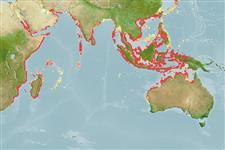Actinopterygii (ray-finned fishes) >
Perciformes (Perch-likes) >
Nemipteridae (Threadfin breams, Whiptail breams)
Etymology: Scolopsis: Greek, skolex = worm + Greek, opsis = appearance (Ref. 45335).
Environment / Climate / Range
Ecology
Marine; reef-associated; depth range 2 - 25 m (Ref. 9710). Tropical, preferred ?; 32°N - 31°S, 29°E - 141°E (Ref. 3810)
Indo-West Pacific: Red Sea and East Africa to the Ryukyu Islands and northern Australia.
Size / Weight / Age
Maturity: Lm ? range ? - ? cm
Max length : 25.0 cm TL male/unsexed; (Ref. 4427); common length : 15.0 cm SL male/unsexed; (Ref. 3810)
Dorsal
spines
(total): 10;
Dorsal
soft rays
(total): 9;
Anal
spines: 3;
Anal
soft rays: 7. Head scales reaching to anterior nostrils. Lower limb f preopercle scaly. Antrorse (forward-directed) suborbital spine present beneath eye. Pelvic fins long, reaching to or just beyond level of anus. Axillary scale present. Color: Variable, usually brownish with a reddish-purple tinge. A broad white vertical bar from top of head onto opercle. Opercular membrane blood-red. Fins greyish with a tinge of red.
Benthic in inshore turbid or weedy waters, usually on sand or mud bottoms close to reefs (Ref. 30573, 90102), as well as offshore areas (Ref. 9785). Seen solitary, but may school deep (Ref. 48635). Feeds on benthic organisms (Ref. 5213). Marketed fresh, salted, smoked or processed into fish balls (Ref. 12484).
Life cycle and mating behavior
Maturity | Reproduction | Spawning | Eggs | Fecundity | Larvae
Russell, B.C., 1990. FAO Species Catalogue. Vol. 12. Nemipterid fishes of the world. (Threadfin breams, whiptail breams, monocle breams, dwarf monocle breams, and coral breams). Family Nemipteridae. An annotated and illustrated catalogue of nemipterid species known to date. FAO Fish. Synop. 125(12):149p. Rome: FAO. (Ref. 3810)
IUCN Red List Status (Ref. 115185)
CITES (Ref. 94142)
Not Evaluated
Threat to humans
Harmless
Human uses
Fisheries: commercial; gamefish: yes
More information
Common namesSynonymsMetabolismPredatorsEcotoxicologyReproductionMaturitySpawningFecundityEggsEgg development
ReferencesAquacultureAquaculture profileStrainsGeneticsAllele frequenciesHeritabilityDiseasesProcessingMass conversion
Tools
Special reports
Download XML
Internet sources
Estimates of some properties based on models
Phylogenetic diversity index (Ref.
82805): PD
50 = 0.5000 [Uniqueness, from 0.5 = low to 2.0 = high].
Trophic Level (Ref.
69278): 3.5 ±0.37 se; Based on food items.
Resilience (Ref.
69278): High, minimum population doubling time less than 15 months (Preliminary K or Fecundity.).
Vulnerability (Ref.
59153): Low vulnerability (24 of 100) .
